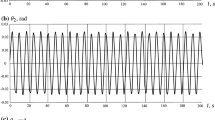Abstract
This paper deals with rigid body attitude estimation on the basis of the data obtained from an inertial measurement unit mounted on the body. The aim of this work is to present the numerical algorithm, which can be easily applied to the wide class of problems concerning rigid body positioning, arising in aerospace and marine engineering, or in increasingly popular robotic systems and unmanned aerial vehicles. Following the considerations of kinematics of rigid bodies, the relations between accelerations of different points of the body are given. A rotation matrix is formed using the quaternion approach to avoid singularities. We present numerical procedures for determination of the absolute accelerations of the center of mass and of an arbitrary point of the body expressed in the inertial reference frame, as well as its attitude. An application of the algorithm to the example of a heavy symmetrical gyroscope is presented, where input data for the numerical procedure are obtained from the solution of differential equations of motion, instead of using sensor measurements.



Similar content being viewed by others
References
Grauer, J.A., Hubbard Jr., J.E.: Flight Dynamics and System Identification for Modern Feedback Control. Woodhead Publishing, Philadelphia, USA (2013)
Barshan, B., Durrant-Whyte, H.F.: Inertial navigation systems for mobiel robots. IEEE Trans. Robot. Autom. 11, 328–342 (1995)
Beard, R.W.: State Estimation for Micro Air Vehicles, Studies in Computational Intelligence, vol. 70, 173–199. Springer, Berlin (2007)
Marins, J.L., Yun, X., Bachmann, E.R., et al.: An extended Kalman filter for quaternion-based orientation estimation using MARG sensors. In: Proceedings of the 2001 IEEE/RSJ International Conference on Intelligent Robots and Systems, Maui, Hawaii, USA, October 29–November 03 (2001)
Chao, H., Coopmans, C., Di, L., et al.: A comparative evaluation of low-cost IMUs for unmanned autonomus systems. In: 2010 IEEE International Conference on Multisensor Fusion and Integration for Intelligent Systems, Salt Lake City, UT, USA, September 5–7 (2010)
Rehbinder, H., Hu, X.: Nonlinear state estimation for rigid-body motion with low-pass sensors. Syst. Control Lett. 40, 183–190 (2000)
Casson, A.J., Galvez, A.V., Jarchi, D.: Gyroscope versus accelerometer measurements of motion from wrist PPG during physical exercise. ICT Express 2, 175–179 (2016)
Wang, X., Xiao, L.: Gyroscope-reduced inertial navigation system for flight vehicle motion estimation. Adv. Space Res. 59, 413–424 (2017)
Izadi, M., Sanyal, A.K.: Rigid body pose estimation based on the Lagrange–d’Alembert principle. Automatica 71, 78–88 (2016)
Luinge, H.J., Veltink, P.H.: Inclination measurement of human movement using a 3-D accelerometer with autocalibration. IEEE Trans. Neural Syst. Rehabil. Eng. 12, 112–121 (2004)
Ma, J., Kharboutly, H., Benali, A., et al.: Joint angle estimation with accelerometers for dynamic postural analysis. J. Biomech. 48, 3616–3624 (2015)
Madgwick, S.O.H., Harrison, A.J.L., Vaidyanathan, R.: Estimation of IMU and MARG orientation using a gradient descent algorithm. In: 2011 IEEE International Conference on Rehabilitation Robotics, Rehab week Zurich, ETH Zurich Science City, Switzerland, June 29–July 1 (2011)
Sabatini, A.M.: Estimating three-dimensional orientation of human body parts by inertial/magnetic sensing. Sensors 11, 1489–1525 (2011)
Santhiranayagam, B.K., Lai, D.T.H., Sparrow, W.A., et al.: A machine learning approach to estimate minimum toe clearance using inertial measurement units. J. Biomech. 48, 4309–4316 (2015)
Esser, P., Dawes, H., Collett, J., et al.: IMU: inertial sensing of vertical CoM movement. J. Biomech. 42, 1578–1581 (2009)
Hamilton, W.R.: On quaternions. Proc. R. Irish Acad. 3, 1–16 (1847)
Goldman, R.: Rethinking Quaternions: Theory and Computation, Synthesis Lectures on Computer Graphics and Animation. Morgan & Claypool Publishers, San Rafael (2010)
Kuipers, J.B.: Quaternions and Rotation Sequences. Princeton University Press, Princeton (1999)
Mukundan, R.: Quaternions: from clasical mechanics to computer graphics, and beyond. In: Proceedings of the 7th Asian Technology Conference in Mathematics, Melaka, Malaysia, December 17–21 (2002)
Spring, K.W.: Euler parameters and the use of quaternon algebra in the manipulation of finite rotations: a review. Mech. Mach. Theory 21, 365–373 (1986)
Fourati, H., Manamanni, N., Afilal, L., et al.: Rigid body motions estimation using inertial sensors: bio-logging application. In: Proceedings of the 7th IFAC Symposium on Medelling and Control in Biomedical Systems, Aalborg, Denmark, August 12–14 (2009)
Fourati, H., Manamanni, N., Afilal, L., et al.: Sensing technique of dynamic marine mammal’s attitude by use of low-cost inertial and magnetic sensors. In: 8th IFAC Conference on Control Applications in Marine Systems, Rostock-Warnemünde, Germany, September 15–17 (2010)
Chou, J.C.K.: Quaternion kinematic and dynamic differential equations. IEEE Trans. Robot. Autom. 8, 53–64 (1992)
Betsch, P., Siebert, R.: Rigid body dynamics in terms of quaternions: Hamiltonian formulation and conserving numerical integration. Int. J. Numer. Methods Eng. 79, 444–473 (2009)
Nielsen, M.B., Krenk, S.: Conservative integration of rigid body motion by quaternion parameters with implicit constraints. Int. J. Numer. Methods Eng. 92, 734–752 (2012)
Xu, X., Zhong, W.: On the numerical influences of inertia representation for rigid body dynamics in terms of unit quaternion. J. Appl. Mech. 83, 061006-1–061006-11 (2016)
Sherif, K., Nachbagauer, K., Stainer, W.: On the rotational equations of motion in rigid body dynamics when using Euler parameters. Nonlinear Dyn. 81, 343–352 (2015)
Diebel, J.: Representing Attitude: Euler Angles, Unit Quaternions, and Rotation Vectors. Stanford University, Stanford (2006)
Durham, W.: Aircraft Flight Dynamics and Control. Wiley, New York (2013)
Goldstein, H.: Classical Mechanics. Addison-Wesley Publishing Company, Boston (1980)
Cooke, J.M., Zyda, M.J., Pratt, D.R., et al.: NPSNET: flight simulation dynamics modeling using quaternions. Presence 1, 404–420 (1994)
Gantmacher, F.: Lectures in Analytical Mechanics. Mir Publishers, Moscow (1975)
Acknowledgements
The project was supported by the Serbian Ministry of Education, Science and Technological Development (Grant 174016).
Author information
Authors and Affiliations
Corresponding author
Rights and permissions
About this article
Cite this article
Zigic, M., Grahovac, N. Numerical algorithm for rigid body position estimation using the quaternion approach. Acta Mech. Sin. 34, 400–408 (2018). https://doi.org/10.1007/s10409-017-0726-z
Received:
Revised:
Accepted:
Published:
Issue Date:
DOI: https://doi.org/10.1007/s10409-017-0726-z



